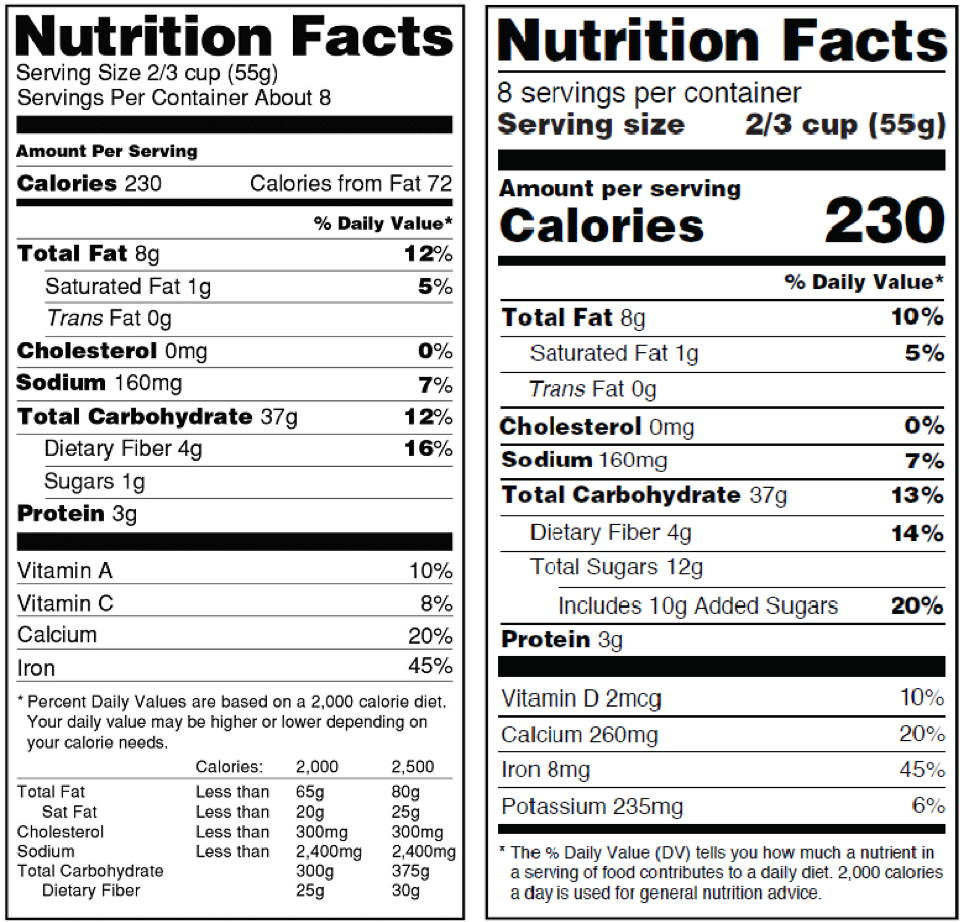20 3.4 Dietary Recommendations and Nutrition Labels
Dietary Guidelines and Key Recommendations
The 2015-2020 Dietary Guidelines for Americans recommend that individuals consume foods which are nutrient-dense from each of the major food groups. Foods that are high in calories (i.e., foods that provide a large amount of energy for the body), but low in nutritional value are referred to as “calorie-dense” foods. Conversely, foods that are high in nutrients (i.e., foods containing an abundance of vitamins or minerals) but are low in calories are referred to as “nutrient-dense.” The 2015-2020 Dietary Guidelines for Americans recommend that individuals consume foods which are nutrient-dense from each of the major food groups for optimal health (DeSalvo, Olson, & Casavale, 2016; Dietary Guidelines Advisory Committee, 2016; Millen, et al., 2016).
- Vegetables
- Grains
- Fruits
- Dairy
- Proteins
- Oils
The 2015-2020 Dietary Guidelines for Americans encourage individuals to make behavioral changes in their eating patterns by focusing on small, healthy dietary shifts or substitutions (such as choosing nutrient-dense foods and beverages in place of less healthy, calorie-dense options). The Dietary Guidelines claim that these healthy behavioral shifts may be achieved by following five overreaching Guidelines: (Dietary Guidelines Advisory Committee, 2016)
- Follow a healthy eating pattern across the lifespan.
All food and beverage choices matter. Choose a healthy eating pattern at an appropriate calorie level to help achieve and maintain a healthy body weight, support nutrient adequacy, and reduce the risk of chronic disease. - Focus on variety, nutrient density, and amount.
To meet nutrient needs within calorie limits, choose a variety of nutrient-dense foods across and within all food groups in recommended amounts. - Limit calories from added sugars and saturated fats and reduce sodium intake.
Develop an eating pattern low in added sugars (Note: added sugars are not naturally found in food, and have been added in the processing or preparation of food), saturated fats, and sodium. Cut back on foods and beverages higher in these components to amounts that fit within healthy eating patterns. - Shift to healthier food and beverage choices.
Choose nutrient-dense foods and beverages across and within all food groups in place of less healthy choices. Consider cultural and personal preferences to make these shifts easier to accomplish and maintain. - Support healthy eating patterns for all.
Everyone has a role in helping to create and support healthy eating patterns in multiple settings nationwide, from home to school to work to communities.
In addition to the aforementioned five Guidelines, the 2015-2020 Dietary Guidelines for Americans outlines several Key Recommendations for how an individual may maintain healthy eating behaviors throughout the lifetime (Dietary Guidelines Advisory Committee, 2016).
- Consume a healthy eating pattern that accounts for all foods and beverages within an appropriate calorie level.
- A healthy eating pattern includes: A variety of vegetables from all of the subgroups—dark green, red and orange, legumes (beans and peas), starchy, and other. Fruits, especially whole fruits. Grains, at least half of which are whole grains. Fat-free or low-fat dairy, including milk, yogurt, cheese, and/or fortified soy beverages. A variety of protein foods, including seafood, lean meats and poultry, eggs, legumes (beans and peas), and nuts, seeds, and soy products. Oils.
- A healthy eating pattern limits: Saturated fats and trans fats, added sugars, and sodium.

The Dietary Guidelines’ Key Recommendations place a quantitative limit on several components of the diet which have been linked to particular public health concerns in the United States. These specified limits are as follows: (Dietary Guidelines Advisory Committee, 2016)
- Consume less than 10 percent of calories per day from added sugars.
- Consume less than 10 percent of calories per day from saturated fats.
- Consume less than 2,300 milligrams (mg) per day of sodium.
- If alcohol is consumed, it should be consumed in moderation—up to one drink per day for women and up to two drinks per day for men—and only by adults of legal drinking age.
In conclusion, the Dietary Guidelines recommend that all individuals also strive to meet the Physical Activity Guidelines for Americans (described in Chapter 1) in order to maintain a healthy body weight, promote health, and prevent chronic disease (Dietary Guidelines Advisory Committee, 2016).
Comprehension check:
Calculating your intake of added sugars and saturated fats may be challenging if you do not know how many calories you have consumed during the day. If you are unsure of your total daily caloric intake, you may follow several simple rules for limiting sugars and fats in the diet. (1) Aim for less than 6 teaspoons or approximately 25 grams (a teaspoon contains approximately 4 grams) of sugar per day (2) Follow the American Heart Association recommendations, and limit your intake of saturated foods to less than 16 grams per day. Do you know where you may find this nutritional information? (Hint: check the Nutrition Facts Label on every food product).
Dietary Reference Intakes (DRIs), Percent Daily Value (DV), and Nutrition Facts Labels
Dietary Reference Intakes (DRIs) are nutrient-based reference values which are utilized in planning and assessing diet components. DRIs include a variety of nutritional standards, and assess adequacy of nutrient intake (Williams, 1999). DRIs do not inform individuals of what specific foods should be consumed.
Daily Values are recommended averages, and are based upon a 2,000 calorie per day diet.The Percent Daily Value (DV) is based upon several DRI values and can be found on nutrition labels. Daily Values are recommended averages, and are based upon a 2,000 calorie per day diet (Williams, 1999). Percent DV is for the entire day, not just one meal or snack. Some individuals may need more or less than 2,000 calories per day (e.g., varying physical activity levels), or may have special dietary requirements (e.g., high blood pressure, leading to potential recommendations from a physician or dietician to limit sodium further and increase intake of magnesium and potassium). Therefore, percent DV may need to be adjusted for the unique needs of the individual.
Nutrition Facts Labels include DV, serving size information, total calories per serving, and an ingredient list. Processed or packaged foods often require a Nutrition Facts label; however, several exemptions include foods manufactured by small businesses and restaurants, ready-to-eat items (such as bakery items), or foods which do not contain a significant amount of nutrients (such as coffee) (Williams, 1999). Recently, the United States Food and Drug Administration (FDA) developed a new design for the Nutrition Facts labels, based upon current scientific evidence linking components of the diet, such as added sugars or saturated fats, to chronic diseases such as obesity and heart disease (U.S. Food and Drug Administration, 2018). This new label is intended to assist consumers in making healthier nutritional choices. The prudent individual will carefully examine a Nutrition Facts label to assess if a particular food product fits into their healthy eating plan.
Comprehension check:
The new Nutrition Facts label is on the right below. Do you believe the changes to the label are effective in helping consumers make prudent nutritional choices? Why, or why not?

Works Cited
DeSalvo, K. B., Olson, R., & Casavale, K. O. (2016). Dietary guidelines for Americans. Jama, 315(5), 457-458.
Dietary Guidelines Advisory Committee. (2016). Dietary Guidelines for Americans 2015-2020. Government Printing Office.
Millen, B. E., Abrams, S., Adams-Campbell, L., Anderson, C. A., Brenna, J. T., Campbell, W. W., … & Perez-Escamilla, R. (2016). The 2015 dietary guidelines advisory committee scientific report: development and major conclusions. Advances in nutrition, 7(3), 438-444.
Williams, M. H. (1999). Nutrition for health, fitness and sport (No. Ed. 5). WCB/McGraw-Hill.
U.S. Food and Drug Administration (2018, January). The new and improved nutrition facts Label – key changes. Retrieved from https://www.fda.gov/files/food/published/The-New-and-Improved-Nutrition-Facts-Label-%E2%80%93-Key-Changes.pdf

